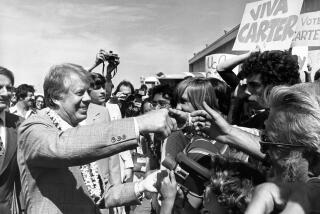Also-Rans May Buttonhole the Winners
- Share via
Question: Can you give some more tips for collecting political buttons in this political year?--R.W.
Answer: Political-button collectors, of which there are thousands, have many criteria for selecting collectible buttons.
One twist is to find buttons of an American president’s successful campaigns for lower offices. For example, “Truman for Senator” buttons have exchanged hands for a couple of hundred dollars each--more than some of his presidential buttons. “Carter for Governor” buttons have great appeal but cost a little less.
Also, look for trivia names of people who ran for the nation’s No. 1 office. For example, in that presidential-candidates-no-one-ever-heard-of category, Republican Calvin Coolidge’s Democratic opponent in 1924 (What! You can’t remember his name?), John W. Davis, issued campaign pins that have commanded more than $1,000 each, given their rarity.
Additionally, some third-party candidates’ campaign buttons have brought high prices over the years, because there are fewer of them than those issued by Democratic and Republican candidates.
Some collectors stay in touch with presidential libraries to keep abreast of buttons and other items about to be marketed. Collectors should be particularly interested in actual campaign memorabilia rather than reissued items.
Q: I’m into a lot of different cowboy collectibles, including Lone Ranger premiums, some of which date back to the World War II period. Actually, how far back do premiums promoting the legendary masked man, Tonto and the great white horse Silver go?--L.F.
A: During the depths of the Great Depression, on Jan. 30, 1933, radio station WXYZ in Detroit aired the first of the incredibly successful Lone Ranger shows. Then, two years later, in 1935, Silvercup Bread backed the first Lone Ranger premium, a Safety Scout membership badge.
By the late 1930s, the Lone Ranger was being marketed on everything from food products to toys and clothing.
Just how popular was the Lone Ranger? This story, thought not to be apocryphal, tells it all:
During a 1930s concert of the Detroit Symphony Orchestra, one of the items on the program was the Lone Ranger’s theme, Gioacchino Rossini’s “William Tell Overture.” As the orchestra went into the familiar theme, a young fan of the masked man stood up and shouted, “Hi-yo Silver! Away!”
By 1941, following sponsorship by a number of bread companies, General Mills took over underwriting the Lone Ranger programs; and the firm’s cereal products, such as Wheaties and Cheerios, became instantly popular across the country.
There was good reason for this. A natural sales tie-in was the cereal box top. Youngsters were urged to mail in cereal-carton tops for Lone Ranger premiums--rings, badges, belts, you name it.
Given the masked man’s enduring popularity, the show’s premiums and associated items are still eagerly sought by collectors here and abroad.
More to Read
Get the L.A. Times Politics newsletter
Deeply reported insights into legislation, politics and policy from Sacramento, Washington and beyond. In your inbox twice per week.
You may occasionally receive promotional content from the Los Angeles Times.









